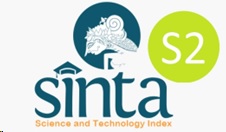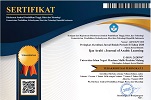DIFFICULTIES OF THE CURRICULUM 2013 IMPLEMENTATION IN ARABIC LANGUAGE AT MADRASAH IBTIDAHYAH/ KESULITAN IMPLEMENTASI KURIKULUM 2013 MAPEL BAHASA ARAB PADA MADRASAH IBTIDAIYAH
Abstract
This research revealed the difficulties of the implementation of the 2013 Curriculum (K-13), especially in Arabic subject in Islamic Elementary Schools/ Madrasah Ibtidaiyah (MI) in Pamekasan, and the inhibiting factors. This study used qualitative research in the form of exploratory research, namely descriptive analysis. The population was all Islamic Elementary Schools (MI) in Pamekasan, and four schools were selected as samples by using purposive sampling technique.
The results showed that from the aspect of designing effective and meaningful learning, as well as in organizing learning, found that MI Islamiyah I Larangan Tokol, Tlanakan did not implement K-13 and did not have Arabic subject syllabus, and so did MI As-Salafi Sumber Duko Pakong. Even, the condition found in MIN 1 Konang, Galis as one of the State Islamic Elementary Schools in Pamekasan is almost the same as the Private Madrasah, because even though they have an Arabic subject syllabus, but it was still in print out syllabus, and the file is not formally legalized by the head of Madrasah. While, in the implementation of learning, it is revealed that teachers were not able to maximize the community, environment, media, and to utilize available internet connection in the learning practice. It happened in almost all Madrasah. Also, teachers of Madrasah Ibtidaiyah in Pamekasan need more training, guidance, and self-improvement in understanding the K-13 concept wholly and comprehensively. On the other hand, Madrasah Ibtidaiyah in Pamekasan did not yet maximize the K-13 concept in term of environmental empowerment as learning resources, and even it is undiscovered the use of andragogy approach, scientific approach, and active learning that should be applied in learning Arabic in Madrasah Ibtidaiyah in Pamekasan.
In general, there are three inhibiting factors which caused the difficulty in the implementation of K-13 in Madrasah Ibtidaiyah in Pamekasan; those include Madrasah and Government’s Policy, lack of qualified teachers, and inadequate facilities. As for the impacts of the difficulty of K-13 implementation for the students can be divided into two aspects: (1) the learning process, and (2) the learning outputs.
Keywords: difficulties of the implementation of the Curriculum 2013; Arabic; Madrasah Ibtidaiyah; Pamekasan regency
Full Text:
PDFReferences
Arikunto, S. (2006). Prosedur penelitian pendekatan praktek. Jakarta: Rineka Cipta.
Hamzah B. Uno, & Nurdin Mohamad. (2013). Belajar dengan Pendekatan PAILKEM. Jakarta: Bumi Aksara.
Lexy, J. M. (2002). Metode penelitian kualitatif. Bandung: Rosda Karya.
Mukminan. (t.t.). Implementasi Kurikulum 2013.
Mulyasa. (2014). Pengembangan dan Implementasi Kurikulum 2013. Bandung: Remaja Rosdakarya.
Oemar Hamalik. (2008). Dasar-Dasar Pengembangan Kurikulum, Cet. II. Bandung: Remaja Rosdakarya.
Permendikbud Nomor 81 A Tahun 2013. (t.t.).
PMA Nomor 0912 Tahun 2013 tentang Kurikulum 2013. (t.t.).
Rakyat, I. M. P. (1973). Ketetapan-ketetapan Majelis Permusyawaratan Rakyat Republik Indonesia Tahun 1973. Departemen Penerangan, Republik Indonesia.
Sugiono, D. (2000). Metode Penelitian. Bandung: Alfa Beta.
Suharsimi, A. (2006). Prosedur penelitian suatu pendekatan praktik. Jakarta: Rineka Cipta.
DOI: https://doi.org/10.18860/ijazarabi.v2i1.5646
Refbacks
- There are currently no refbacks.
Copyright (c) 2019 Nurul Hadi
License URL: https://creativecommons.org/licenses/by-sa/4.0/












